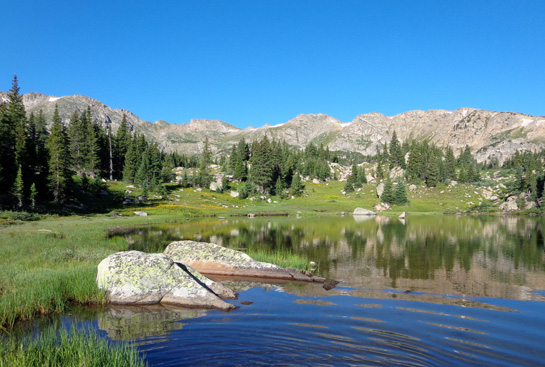Great advice for cities like Savannah, Georgia and Charleston, South
Carolina -- to most appreciate the architecture, gardens, park
squares, old cemeteries, monuments, and relics in their historic
districts, visitors really need to walk around so they can see the unique details.
The period houses are gorgeous and the city is far enough south that
some type of flower is blooming even in January (camellias, for
example). Founded in 1733, the city is a goldmine for history buffs of all types.
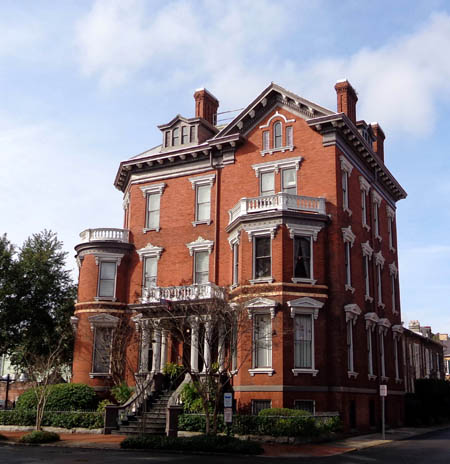
Quintessential Savannah (Kehoe
House, now an inn)
While we've been in Savannah Jim and I have been to the Historic
District five or six times to explore.
There are so many notable houses, churches, and other buildings that I
can't name all the ones I'm including in this entry. I'll identify only
the photos I'm fairly certain of.
FIRST STOP: THE SAVANNAH VISITOR CENTER
Although I visited Savannah several times during the 25 years I lived in the metro
Atlanta area, it has been a couple decades since I've been here.
I'd forgotten more details than I remembered. This is
Jim's first time to visit the city so we both saw it with fresh eyes.
Soon after our arrival we drove downtown to the impressive
visitor center to read some historical information and gather current brochures
and maps:
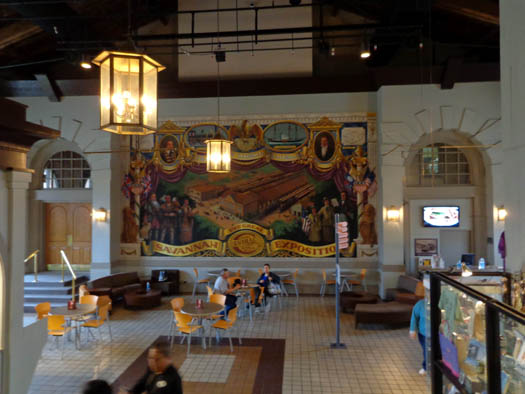
The visitor center is housed in a handsome red brick building that
was built in the mid-1800s and used as the passenger terminal of a
railroad for over 100 years.
When we went back outside we talked with two different trolley tour
operators waiting in the parking area, drumming up business.
We decided that a narrated trolley tour would be a good way for us to get an
overview of the historical district before setting out on foot. That way
we could zero in later on particular areas where we wanted to focus our
attention.
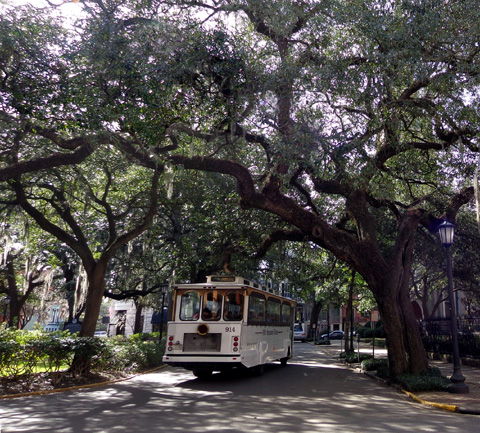
A tour bus slowly wends its way through the
Historic District.
Each of these companies has several tour options and prices. Because it
was late afternoon on a cloudy Thursday and they didn't have a lot of
customers, the prices they offered were lower than normal.
It was too late that day for us to be interested in a tour so we just
asked some questions and didn't buy tickets yet.
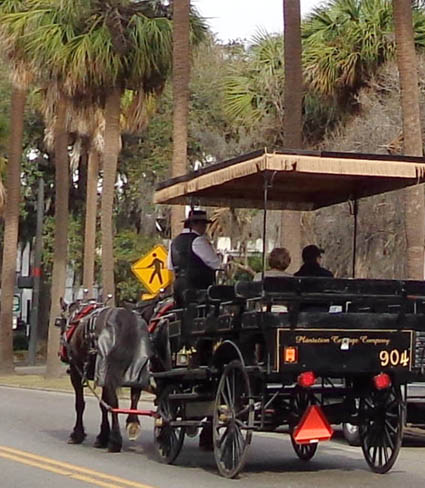
Note that horse-drawn carriage tours, such as the one shown in the
photo above, are a personalized and romantic way to see Savannah but
are more expensive than trolley tours and usually don't cover as much territory.
TROLLEY TOUR
The next morning, a Friday, was sunny and warm. We decided it would be a
good day for our trolley tour.
Based on the answers to our questions the day before, and the other
information we read about the two trolley companies operating from the
visitor center, we chose Old Savannah Tours. We parked in the company's
free parking area across the street from the visitor center and got
on/off the trolley at the visitor center.
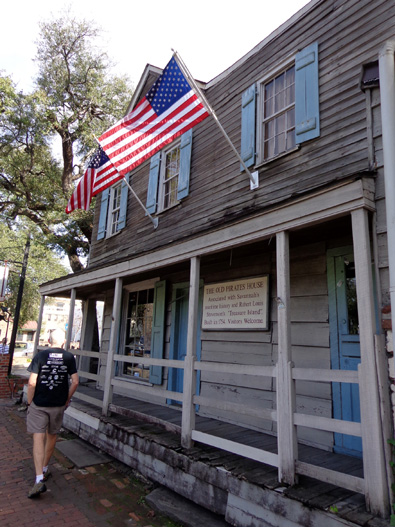
The old
Pirate's House, built in 1754, is now a popular restaurant.
Old Savannah Tours has
several tour options, including ones where you can get on/off at any of
the sixteen stops along their route, ghost tours ("hauntings"), tours that include the
Pirates' House restaurant or a tour inside the Sorrel-Weed House, and others.
We chose the basic 90-minute "Overview" tour so we'd see a larger area
of the Historic District.
The regular price of this tour is $26/person. Our military rate was $15 each (even on
a sunny morning) and we felt like we got our money's worth. Our older
trolley driver/tour guide, also named Jim, was excellent -- very
articulate, with a lot of information and some humor.
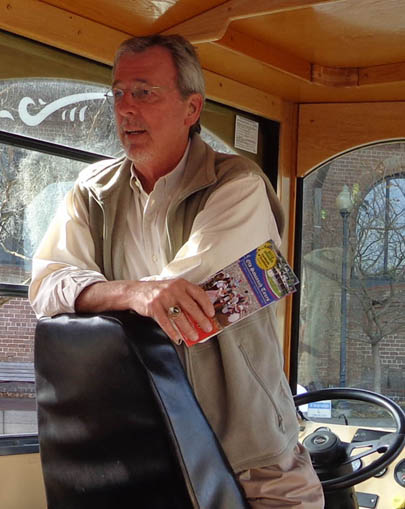
Jim was an excellent driver and tour guide.
This tour stops briefly at sixteen places for passengers to get on and
off, if they want. We didn't get off anywhere because we planned to go
back to several of the places later to explore further on our own.
While stopped, the driver gave us information about the surrounding
area. In addition, he talked quite a bit as he drove past various
notable buildings and squares. At two of our stops a young woman in period dress got on the trolley and
gave a five-minute presentation. One was the Sorrel-Weed House and the
other was on River St.
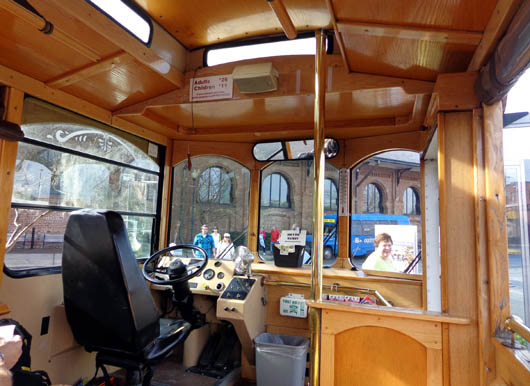
View from inside a trolley car
We enjoyed the open-air trolley, which held about two dozen people. We
sat on the non-drivers' side, which was best for pictures of houses and
other buildings but not the park squares. Those were on the driver's
side during this tour.
About these
squares . . .
When General
James Oglethorpe and Colonel William Bull laid out their new settlement
in the early 1730s they centered all the residential and commercial
buildings around 24 public squares, which became lovely parks full of
trees, grass, fountains, and statues.
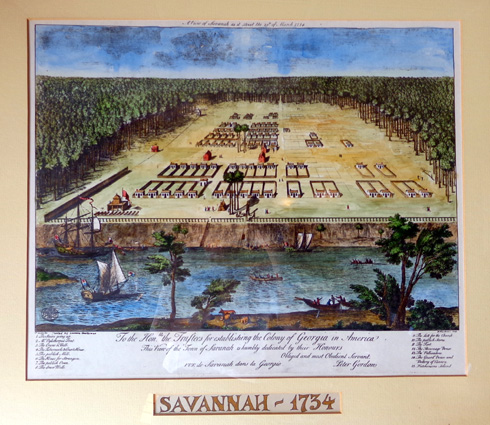
Artist's depiction of
the layout of the new town
This is a portion of one of the squares as it looks today:
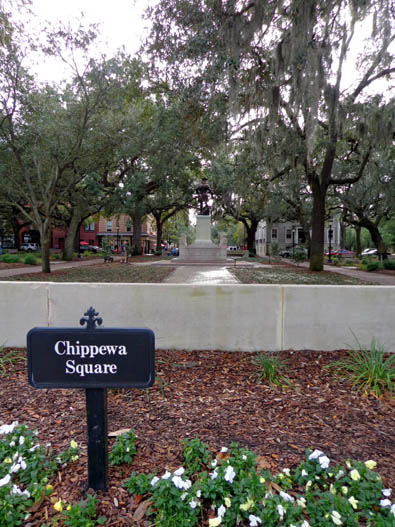
Above and
below: Chippewa Square was used
in a scene in the movie, "Forrest Gump."
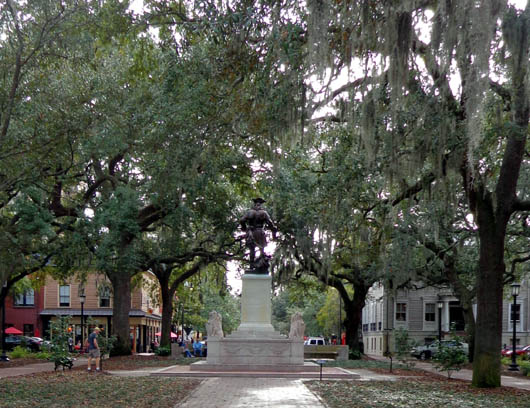
Twenty-two of
those squares remain today. They are surrounded by the beautifully
restored homes for which Savannah is famous.
We drove back to the
Historic District several more times after our trolley tour to explore the area on foot
and in our vehicle. It would also be nice to tour the District on a bicycle.
GET OUT AND WALK
Historic Savannah is pedestrian-friendly -- more pedestrian
friendly than car- or truck-friendly because of the narrow streets and
difficulty finding parking. You can join a narrated walking tour or just
park somewhere and start walking on your own.
When you strike out on your own it helps to get a walking tour map at
the visitor center first, or at least read tour guides and free
promotional material about the history and architecture of some of the
houses and other things you'll be seeing.
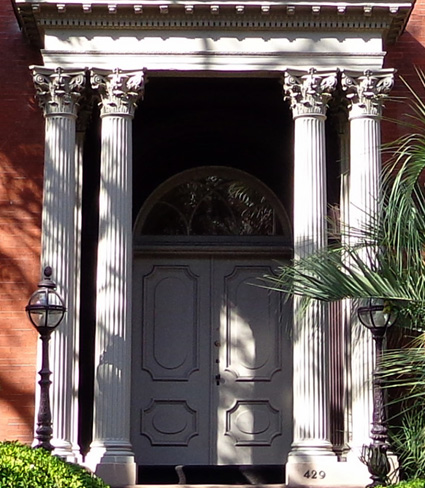
Stately Greek columns define the entrance to the
Mercer Williams House at 429 Bull Street.
Sometimes we followed tour maps part of the way. Other times we just
picked a street, found a parking place, and started walking.
You can also learn-as-you-go. Some old houses and buildings in
Savannah have signs out front with information about when they were built,
the architectural style, who designed the house, who lived there
originally, etc.
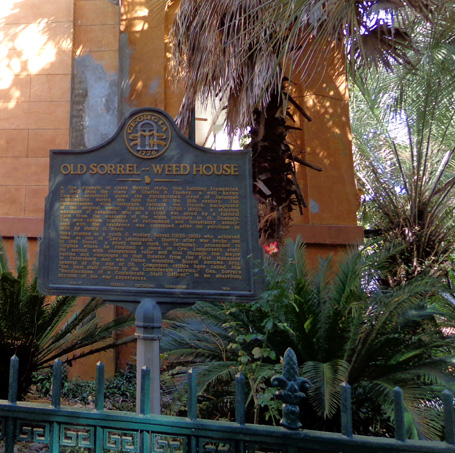
While walking we were able to focus on interesting architectural
details, little gardens mostly hidden from the street, and other things
we missed when driving or riding the trolley.
For example, our guide
pointed out the interesting dolphin downspouts (below) during our
trolley tour but we didn't get a close view until we were out walking
one day and spotted them:
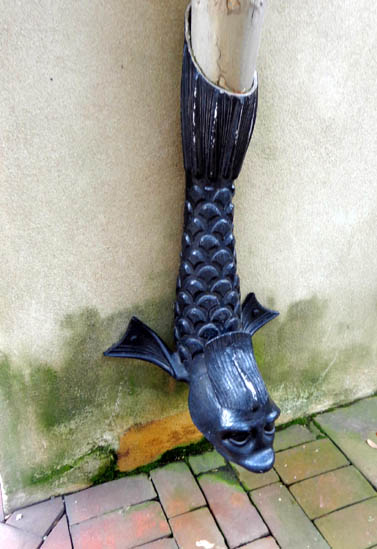
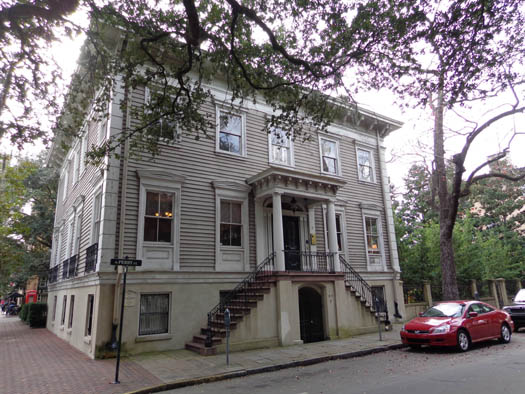
Each front corner of this house has dolphin
downspouts.
A few of the grandest homes offer interior tours for a price, if you
want to see inside.
We didn't pay to go into any houses on this trip. Jim wasn't
interested and I've already seen enough elegant old homes in my
lifetime. About the only one I'd consider visiting again is the Biltmore
estate in North Carolina. Grand houses don't get any bigger or more
elegant than that!
If you don't have time or are unable for other reasons to do a
walking tour of Savannah's historic area, I highly recommend you take
a carriage or trolley tour with an experienced driver who can describe
what you're seeing. I think that really enhances the experience.
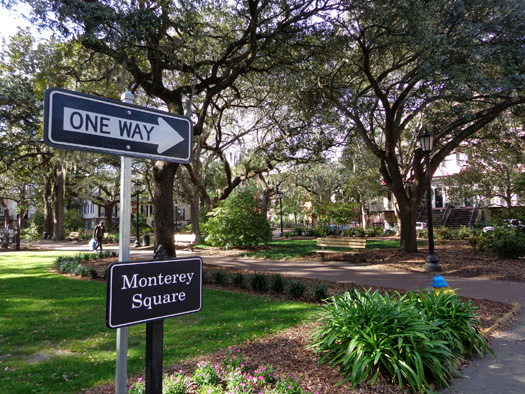
Some of the streets around the
squares in the Historic District are one-way.
You can also explore the Historic District in your own vehicle. The
downside is that old neighborhoods with narrow streets can be difficult to navigate
and the driver can't see much of anything while driving.
I managed to take quite a few photos during our trolley ride, driving
tours, and walking tours of the Historic District. I'll share more of
them in various categories below and on the next two pages.
MORE HOUSE PHOTOS
You might be wondering how there can be so many
beautiful old houses in Savannah after Sherman's devastating march to
the sea during the Civil War. The city got lucky there. His troops
destroyed most of the old cemetery where they were quartered while
occupying Savannah but they didn't destroy the houses.
However, Savannah suffered four huge fires in
the late 1700s and early 1800s. After that, fewer wooden houses were
built; most were constructed of brick and stone.
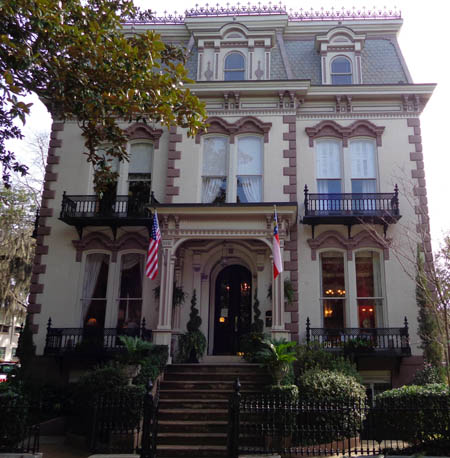
Hamilton-Turner House, now an inn (completed in 1873)
During the
trolley tour our guide talked about historic preservation and
restoration efforts made during the 20th Century.
We can thank
the tireless efforts of the Historic Savannah Foundation, one of the
country's first and most successful urban restoration projects, for
these magnificent houses and other civic restoration done to the
warehouses and cotton brokerage offices on the city's historic
riverfront.
Even today there are strict rules re: what owners can do to the
exterior of their homes and businesses in the Historic District, even if
all they want to do is to repaint the same color!
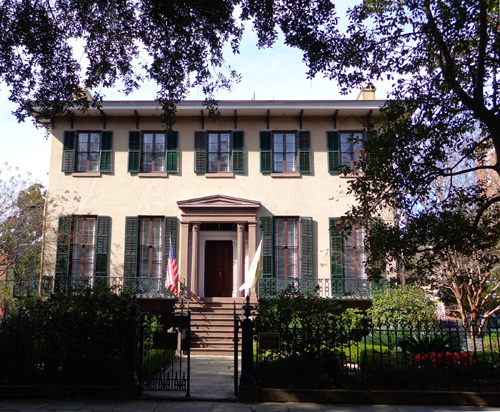
The Andrew Low House, stuccoed
brick Italianate style completed in 1848, is now a museum.
Every time it needs to be painted, the owners need
the approval of the historic foundation.
Some residents object to all the regulations but the rules have
definitely helped the District to maintain its character and
continue to draw tourists from around the world.
Here are more photos
of interesting houses in the Historic District. Some are private homes.
I'll identify the ones I know are open for public tours (for a price).
You can read more about them by doing an online search.
Our trolley tour
guide suggested that if we had time to go into only one house while we
were in Savannah, the Owens-Thomas House is the best value:
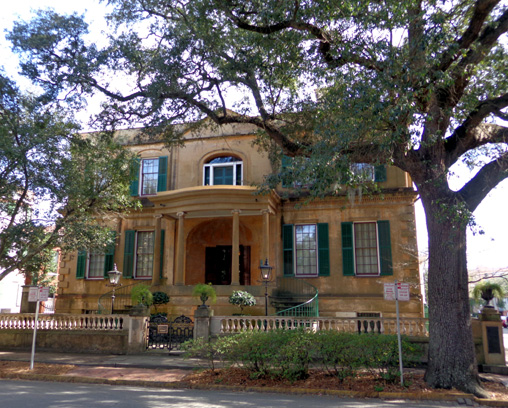
Owens-Thomas House museum at Oglethorpe Square
This house was designed by renowned architect William Jay when he was a
mere 20 years old. It's described as one of the finest examples of Greek
Revival style from the English Regency period in the country. The house
was built over a four-year period of time for Richard Richardson, a
local merchant, and completed in 1820.
The Mercer-Williams House is also open for tours:
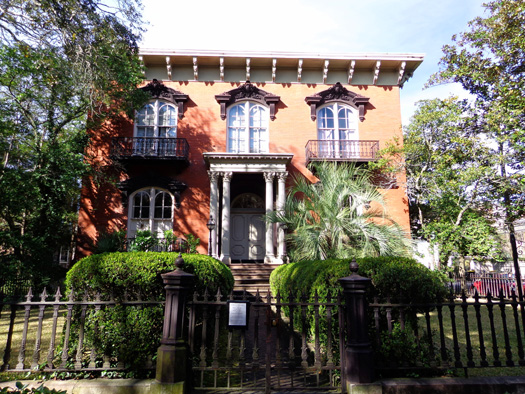
Mercer Williams House
This mansion was built in 1860 and is known today for its scenes from
the movie, "Midnight in the Garden of Good and Evil."
The Sorrel-Weed House, a Greek Revival/Regency-style home completed in
1840, is also open for historical and ghost tours:
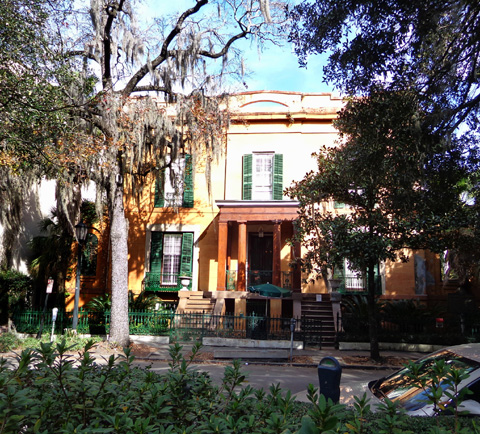
Sorrel-Weed House
The historic Davenport House, also open for tours, is an example of the
Federal style. It was built in 1820:
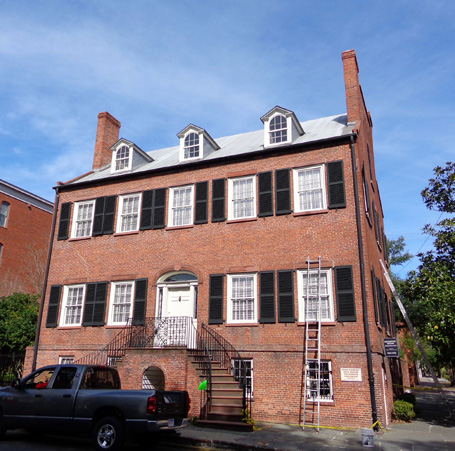
Davenport House
The handsome Kehoe House, a Renaissance Revival-style home built in
1892, is now an historic inn:
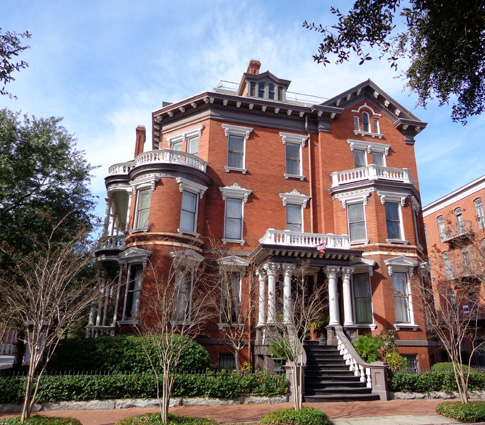
Kehoe House
The next two photos show another elaborate Italian Renaissance mansion
that is now part of Armstrong Junior College. It was completed in 1915:
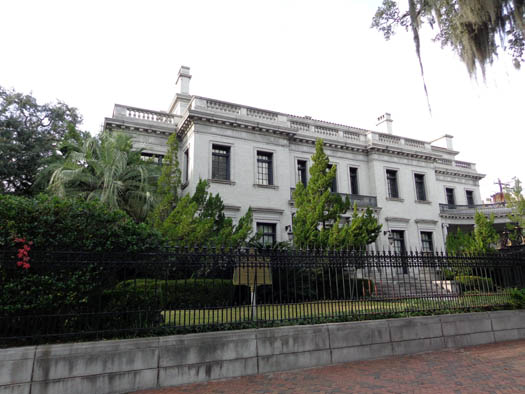
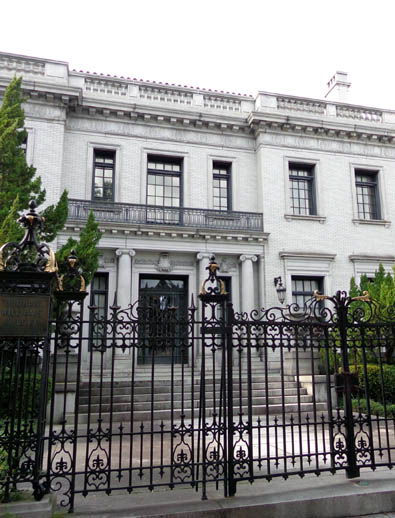
Many Savannah homes have intricate wrought-iron fences and gates. That is one of the more elaborate ones.
There is one very tiny house in the Historic District that our trolley
driver pointed out, commenting that it fetched over $300,000 when it
sold last year:
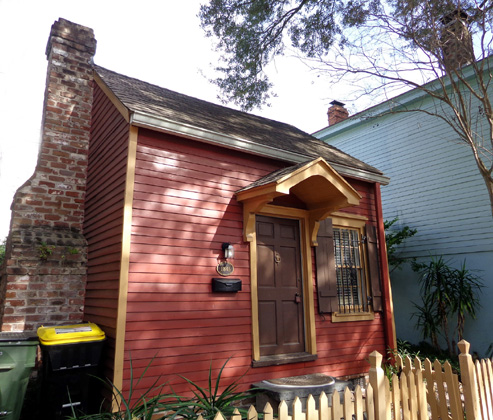
It is dwarfed by the large homes on either side. Can you imagine what
some of the mansions in these photos are worth??
Here are are a couple other handsome houses in the Historic District
that are private residences, to the best of my knowledge:
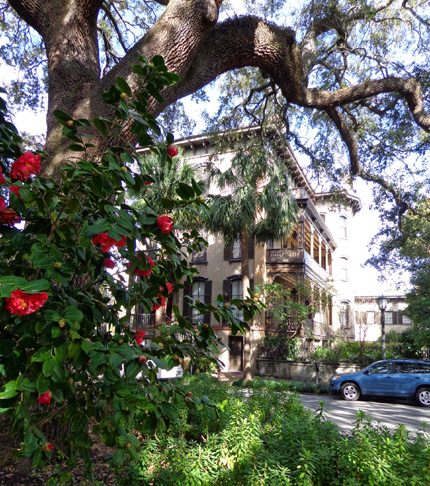
View of a house from one of the squares; not the
flowering camellias.
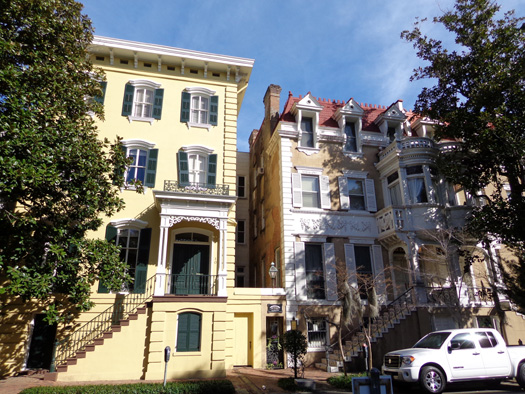
Typical four-story single houses
Continued on the next page: photos of other historic
buildings, public squares, and parks
Happy trails,
Sue
"Runtrails & Company" - Sue Norwood, Jim O'Neil,
Cody the ultra Lab, and Casey-pup
Previous
Next
© 2013 Sue Norwood and Jim O'Neil
